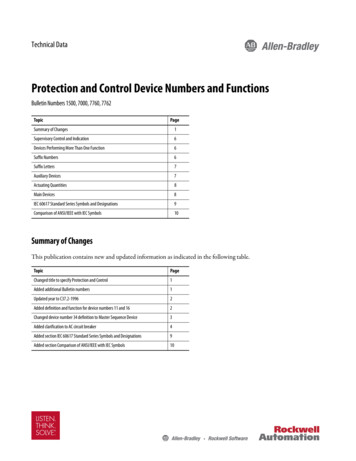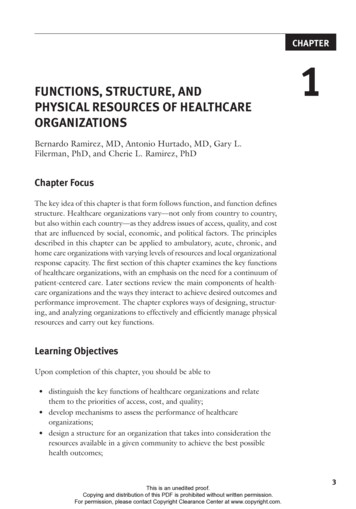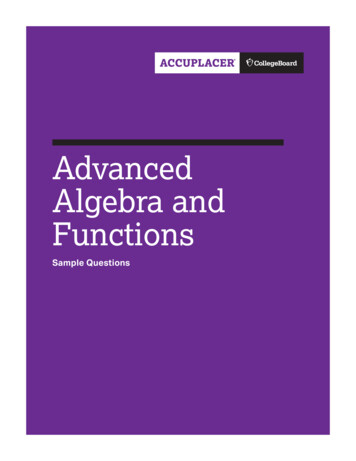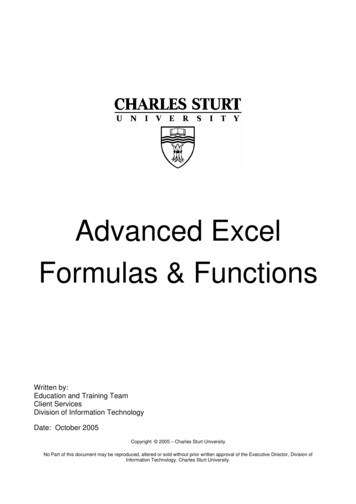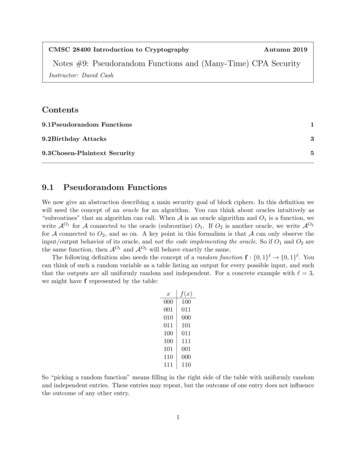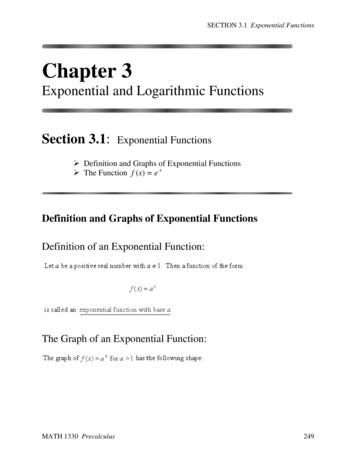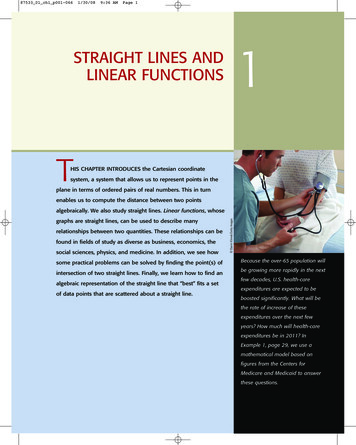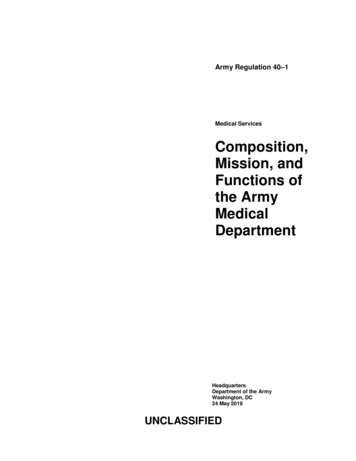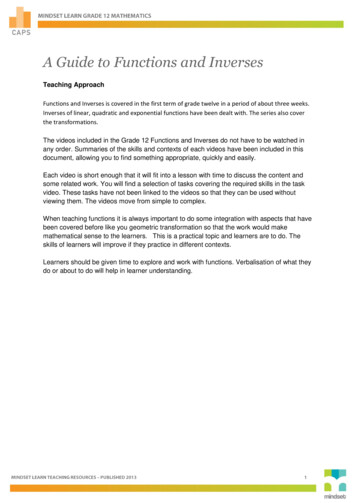
Transcription
A Guide to Functions and InversesTeaching ApproachFunctions and Inverses is covered in the first term of grade twelve in a period of about three weeks.Inverses of linear, quadratic and exponential functions have been dealt with. The series also coverthe transformations.The videos included in the Grade 12 Functions and Inverses do not have to be watched inany order. Summaries of the skills and contexts of each videos have been included in thisdocument, allowing you to find something appropriate, quickly and easily.Each video is short enough that it will fit into a lesson with time to discuss the content andsome related work. You will find a selection of tasks covering the required skills in the taskvideo. These tasks have not been linked to the videos so that they can be used withoutviewing them. The videos move from simple to complex.When teaching functions it is always important to do some integration with aspects that havebeen covered before like you geometric transformation so that the work would makemathematical sense to the learners. This is a practical topic and learners are to do. Theskills of learners will improve if they practice in different contexts.Learners should be given time to explore and work with functions. Verbalisation of what theydo or about to do will help in learner understanding.
Video SummariesSome videos have a ‘PAUSE’ moment, at which point the teacher or learner can choose topause the video and try to answer the question posed or calculate the answer to the problemunder discussion. Once the video starts again, the answer to the question or the rightanswer to the calculation is given.Mindset suggests a number of ways to use the video lessons. These include: Watch or show a lesson as an introduction to a lesson Watch of show a lesson after a lesson, as a summary or as a way of adding in someinteresting real-life applications or practical aspects Design a worksheet or set of questions about one video lesson. Then ask learners towatch a video related to the lesson and to complete the worksheet or questions, either ingroups or individually Worksheets and questions based on video lessons can be used as short assessments orexercises Ask learners to watch a particular video lesson for homework (in the school library or onthe website, depending on how the material is available) as preparation for the next dayslesson; if desired, learners can be given specific questions to answer in preparation forthe next day’s lesson1. Defining a FunctionWe discuss the definition of a function. The distinction between a function and a relationis given. The test for a function is given. Mapping is used to show that some relations arenot functions.2. Vertical TranslationsWe discuss how we translate functions vertically. The upward and downward movementsare explained. We also discuss the notation so that translations can be identified withease.3. Horizontal TranslationsThis video seeks to explain fully the movement horizontally of the functions. The notationis explained so that horizontal movements can be identified easily. The sign in thedetermines the direction of your movement.4. Reflections of FunctionsWe have focus on the reflection on the axes in this video since the other types oftransformations have been fully covered in other videos.5. How to Stretch a FunctionIn this video, we show and explain how functions are stretched. The notation that gives usthe stretch is given.6. Discovering Inverse FunctionsWe define an inverse of a function. We discuss how we get the equation of an inversegiven the equation of the original function. We integrate inverses with reflection in the liney x. We give reasons why logarithms are used for inverses of exponential functions.
7. Inverse of a Linear FunctionThe method of getting the equation of an inverse of a linear function is discussed. It isalso given that the gradient would remain the same but the y-intercept would mostprobable change.8. Inverse of an Exponential FunctionWe discuss why we use the logs in the inverse of an exponential function. Theasymptotes are fully explained. The use of the reflection line y x is explored andexpounded on. The log function is covered in this video.9. Inverse of a Quadratic FunctionThe equation of the inverse of a quadratic function is discussed. The reason why theinverse of a quadratic function is not a function is given and tested. The use of the turningpoint to restrict the domain so that the resultant inverse can be a function is given.Resource MaterialResource materials are a list of links available to teachers and learners to enhance their experience ofthe subject matter. They are not necessarily CAPS aligned and need to be used with discretion.1. Defining a Function2. Vertical Translations3. Horizontal Translationshttp://en.wikipedia.org/wiki/Function anslations.htmDefining a functionWorked examples (Functionstutorial)Worksheet on functionsDefines vertical translationInteractive vertical shiftingNotes on translationsWorksheet on vertical shiftDefines vertical translationInteractive vertical shiftingNotes on translationsWorksheet on vertical shift
4. Reflections of Functions5. How to Stretch a Function6. Discovering InverseFunctions7. Inverse of a LinearFunction8. Inverse of an ExponentialFunction9. Inverse of a G zXtVBsh0A summary of stretches or shrinksDefining a stretchStretching of graphsInteractive question and answeron application of functionsTeacher’s guide molik/InverseLinear.pdfApplications of hphttp://www.math.uh.edu/ ajajoo/MATH1310/LectureNotes/1310 Notes 5o3 http://www.youtube.com/watch%3Fv%3DeZPTwxSN ratic-FunctionThe equation of the inverse of alinear adratic/Quadratic rg/teaching/AdvAlgebra/Functions .09.07/s/elliot1.phpWorksheet and erse quadratic.htmlProperties of exponentialfunctionsTeacher school worksheetsWorked examplesDefining an inverse of a function.Domain and range of inverse of afunction.The procedure for finding theinverse of a linear functionTutorial on how to solve/findinverses of a functionThe graph of the logarithm andexponential functionHow to inverse exponentialfunctionsVideo of exponential functionTo determine inverse of aquadratic functionLesson plans and worksheetWorksheets on transformation ofexponential function
TaskQuestion 1Given ( )and ( )()1.1 Sketch the graphs of and on the same set of axes. Indicate Intercepts and anyturning points1.2 Findin the form1.3 Sketch the graph of() on the same set of axes indicate any two points1.4 For which values of x is the graph of() 1.5 Describe the transformation that maps ( ) onto ( ) - ()1.6 Show algebraically, that ()( )Question 2The graph of( )is sketched.() is a point on the graph of m.2.1 Write down the co-ordinates of the. Give a reason for your answer2.2 Calculate the value of b2.3 Write down the equation of the inverse function,in the form2.4 What is the domain and the range of( )2.5 Write down the equation of the asymptote of ( ) if ( )Question 3()Sketched below are the graphs of ( )and ( ), where b is aconstant. The graphs of and intersect at C. D is the turning point of g.3.1 Show that b 33.2 Write down the coordinates of the turning point of g.3.3 Write down the equation of( ) in the form of y .3.4 Write down the domain and the range of3.5 Sketch the graph of
3.6 How can the domain of g be restricted so that()3.7 Write down the equation of if ( )(3.8 Explain why the maximum value of)will be a function?is 27Question 4Sketched below are the graphs of ( )()( )and ( )Points (-1;10) and (1;2) are on g. The intercepts of f are at (-1;0) and (5;0) and (0;-10)4.14.24.34.44.54.64.7Find the x and y-intercepts of hFind the equation of f and gWrite the equations of the asymptotes ofIf ( )( ), write down the equation of .Given ( )( ); write down the turning points of()Sketch( )Determine the values of x for which( )– ( ).
Task AnswersQuestion 11.11.2 ( );1.31.4 In; whenin the inverse of y whenandis the asymptote ofwe can conclude that for ()then;1.5 It’s a reflection in the x-axis followed by a translation of 13 units down.1.6 () (3)( )Question 22.1 The coordinates for the y-axis are (0;1) because
2.2Since the numerators are equal the denominators must be equal as well.Therefore b 4.2.3( )2.4,2.5Question 33.1 At the point of intersection of the two graphs x 1 andtherefore the value of b is 3.3.2 The turning points are (1;3)3.3 y 3.43.53.63.7 ( )(())3.8 We get the maximum when (x-1)2 is least. (x-1)2 is least when x is equal to 2. Because that is theonly time we get a zero, otherwise all other values will give us a positive answer.
Question 44.1 For the x-intercept()()For the y-intercept4.2()( )()((()())((()())))( )4.34.4( )( )()4.5 Turning point of k( )( )( )( )()( )( )()Therefore the turning points of k(x) are (2; -18)
4.6 ( )( )(4.7(()()))AcknowledgementsMindset Learn Executive HeadContent Manager Classroom ResourcesContent Coordinator Classroom ResourcesContent AdministratorContent DeveloperContent ReviewerDylan BusaJenny LamontHelen RobertsonAgness MunthaliSihlobosenkosi MpofuMlamuli JiyaneProduced for Mindset Learn by TrafficFacilities CoordinatorFacilities ManagerDirector:Editor:Presenter:Studio CrewGraphics:Cezanne ScheepersBelinda RenneyAlriette GibbsNonhlanhla NxumaloBelinda RenneyJT MedupeAbram TjaleWayne Sanderson.This resource is licensed under a Attribution-Share Alike 2.5 South Africa licence. When using thisresource please attribute Mindset as indicated athttp://www.mindset.co.za/creativecommons
A Guide to Functions and Inverses Teaching Approach Functions and Inverses is covered in the fir
